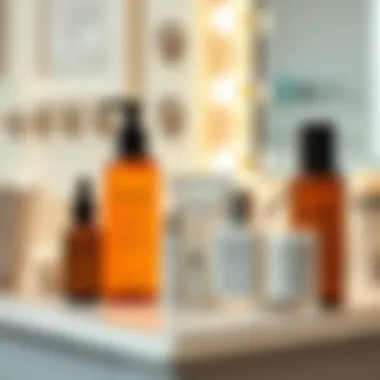Glycolic Acid Exfoliators for Smoother Legs


Intro
In the world of skin care, exfoliation holds a significant position. It's like giving your skin a fresh lease on life, and glycolic acid, in particular, stands out as a key player. But we are not just chatting about any old exfoliant; we’re diving into glycolic acid and how it can transform not just your facial skincare routine but also your leg care regimen. The skin on our legs often gets neglected, which is rather surprising given how much it does for us every day.
Well-Being Overview
Glycolic acid is a naturally occurring alpha-hydroxy acid derived from sugarcane. Its small molecular size gives it powerful penetration abilities, making it a preferred choice for exfoliation. When used on legs, glycolic acid can assist in sloughing away dead skin, promoting cell turnover, and giving your legs a smoother appearance. The importance of incorporating glycolic acid in your leg care cannot be overstated, as it addresses issues such as dryness, rough texture, and uneven skin tone effectively.
Why Focus on Leg Care?
Leg care may not always be the first thing on your mind when planning a skincare routine, but just like the rest of your body, your legs deserve attention. Whether it’s summer shorts or an elegant dress in winter, confidently showing off your legs means they should look their best. Not only does smoother skin enhance your appearance, but it also cultivates a sense of well-being, fostering self-confidence and personal pride.
“Caring for your skin is an essential part of taking care of yourself. It's not just skin deep; it’s about feeling good in your own skin.”
Making it a point to care for your legs can also support broader aspects of mental and physical health. Healthy skin is often linked to general well-being, so let’s explore how glycolic acid can serve as a beneficial ally in your quest for pampered legs.
Foreword to Glycolic Acid
Glycolic acid sits at the forefront of the skincare revolution with its remarkable potential, particularly for leg care. As an alpha hydroxy acid (AHA), it’s recognized not just for its exfoliating abilities but also for the broader spectrum of skin benefits that come with its use. Understanding glycolic acid's nuances can help individuals and professionals alike make informed choices in skincare routines, especially concerning leg care, where skin texture and appearance play critical roles.
Chemical Composition
At its core, glycolic acid is a simple molecule, composed of carbon, hydrogen, and oxygen. Specifically, it has the chemical formula C2O3, which denotes its role as a small yet effective acid. This small size allows it to penetrate the skin more deeply than larger molecules, setting the stage for its exfoliation and rejuvenation properties.
In practical terms, glycolic acid sloughs off dead skin cells that build up on the surface, revealing fresher, more vibrant skin underneath. This process can diminish dark spots and uneven skin tone, an all-too-common issue for those aiming for better leg care. Importantly, it also aids in moisture retention, helping the skin on the legs maintain a healthier barrier against environmental stressors.
Origin and Synthesis
Glycolic acid is primarily derived from sugar cane, and its journey from nature to the bottle is quite fascinating. The extraction process involves juicing the sugar cane and then fermenting it, which results in the formation of glycolic acid. This simple, natural origin underpins its appeal — it aligns with the increasing trend towards using more naturally derived ingredients in skincare products.
Commercially, glycolic acid can be synthesized through various chemical processes as well, giving manufacturers flexibility in formulations. While products can come from natural sugars, synthetic versions are designed to mirror their natural counterparts closely.
For those in the health and wellness industry, understanding both the natural and synthetic roots of glycolic acid can inform discussions about ingredient sourcing and product efficacy.
"Glycolic acid is the workhorse of exfoliants, offering not just immediate skin benefits but also long-term improvements when used correctly."
This leads to a better appreciation of its application in leg care and how it can contribute to overall skin health. As the following sections will elucidate, the benefits of incorporating glycolic acid into leg treatments go beyond mere aesthetics.”
Understanding Exfoliation and Its Importance
Exfoliation is a crucial aspect of skincare that often gets overshadowed by other beauty routines. Nevertheless, understanding its importance can significantly enhance skin health, particularly for areas like the legs that might not always receive the attention they deserve. Exfoliating helps to remove dead skin cells, dirt, and impurities that accumulate on the surface of the skin, which can lead to a more vibrant appearance. Furthermore, it encourages the turnover of new skin cells, thus refreshing and rejuvenating the skin's surface.
The Role of Exfoliation in Skin Health
Exfoliation serves multiple roles in maintaining healthy skin. First and foremost, by clearing away the dead skin layers, exfoliation improves the absorption of moisturizers and treatments applied afterward. Think of it this way: if your skin is cluttered with dead cells, it’s much like trying to pour water onto a dirty windshield; not much will penetrate. With exfoliation, you’re cleaning that surface, allowing treatments to work more effectively.
Another benefit of regular exfoliation is its ability to prevent clogged pores, which can lead to acne and other skin issues. Particularly for those with leg hair, when hair follicles get blocked by debris, it can result in ingrown hairs —something many seek to avoid. A gentle application of glycolic acid exfoliator can assist in keeping these follicles clear and reduce the likelihood of such complications.


"Exfoliation can be a game changer for maintaining smooth, healthy-looking skin. Regular care opens the door to a more even tone and texture."
Additionally, letting new skin cells shine through contributes to a healthier skin tone. This revitalization can combat the dullness that naturally occurs with age or environmental factors. Plus, people often find that their skin feels softer and more supple after regular exfoliation. Keeping this routine can also instill a sense of self-care and mindfulness, which is essential in today’s fast-paced world.
Differentiating Physical and Chemical Exfoliants
When diving into exfoliation, it’s vital to understand the two broad categories: physical and chemical exfoliants.
Physical exfoliants involve scrubbing or rubbing the skin with granules or tools. Think sugar scrubs or loofahs. These methods rely on the manual removal of dead skin and can often lead to immediate texture improvements. However, they can sometimes be harsh, especially for sensitive skin
Chemical exfoliants, on the other hand, like glycolic acid, work on a molecular level to dissolve the bonds holding dead skin cells together. They’re generally gentler —a blessing for those with sensitive skin. By opting for chemical exfoliation, you allow for a more consistent treatment without the risk of micro-tears that physical methods could cause.
Benefits of Glycolic Acid for Leg Care
Glycolic acid, a member of the alpha hydroxy acid family, has gained traction in the skincare world for its rejuvenating properties. For the legs, which can often receive less attention than other areas, the benefits of incorporating glycolic acid into a routine can be remarkably pronounced. This section will delve into the distinct advantages glycolic acid offers, addressing its potency in promoting skin renewal, enhancing texture and tone, and addressing the ubiquitous nuisance of ingrown hairs.
Promoting Skin Renewal
The skin naturally sheds dead cells through a process called desquamation. However, this process can slow down over time, leading to dryness and dull appearance, especially on the legs where moisture retention can be an issue. Glycolic acid works as a powerful catalyst in this context; it breaks down the bonds between dead skin cells, allowing them to be sloughed away more efficiently. This results in smoother skin that reflects light better, creating that coveted healthy glow.
Using glycolic acid regularly helps stimulate the production of new skin cells. This boosts collagen synthesis, which is particularly crucial as one ages. A routine that includes glycolic acid can lead to skin that appears more youthful and vibrant. The transition may take some time, and applying sufficient amounts over weeks or even months is key to realizing these benefits. This is not just about surface-level radiance; it’s about fostering deep, structural health within the skin.
Improving Skin Texture and Tone
Uneven skin tone and rough texture can be frustrating issues for many. Glycolic acid possesses the unique ability to exfoliate while also working to even out skin pigmentation. Whether it's discoloration from sun exposure or marks from past injuries, regular application can help to blur the appearance of these imperfections. The acid's small molecular structure enables it to penetrate the skin effectively, addressing issues right at the root.
Furthermore, the gentle acid can soften and refine the surface of the skin, leading to a noticeably smoother feel. This is particularly beneficial for those who sport longer dresses or shorts and prefer skin that looks as good as it feels. Consistent use can even minimize the appearance of fine lines and give the legs an overall youthful firmness and suppleness.
Minimizing Ingrown Hairs
Ingrown hairs can be a persistent source of irritation for individuals who shave or wax their legs. When hairs curl back into the skin rather than growing outward, they can cause painful bumps and blemishes. Glycolic acid can play a pivotal role in preventing this annoyance. By promoting exfoliation, it allows free access for hairs to grow outward without obstruction.
Incorporating glycolic acid can also help to soothe inflammation associated with ingrown hairs, reducing the redness and discomfort. Regular use will lead to a smoother leg appearance, minus the unsightly bumps. An easy and effective way to incorporate glycolic acid is to look for toners or lotions specifically formulated for leg care that contains this key ingredient.
"Smooth skin is not just a cosmetic feature, but a confidence booster that can transform how a person feels day-to-day."
In summary, the benefits of glycolic acid for leg care are clear and varied. From skin renewal to improving tone and minimizing unsightly ingrown hairs, this compound offers an arsenal of advantages. Integrating it into a skincare routine can elevate one’s leg care game, ensuring that the lower body receives its fair share of pampering and attention.
How to Use Glycolic Acid Exfoliators on Legs
Using glycolic acid exfoliators on the legs can transform your skin health, but understanding the right approach is crucial. Improper use can lead to irritation or dissatisfaction with the results. Thus, knowing how to effectively apply these products can save you from potential pitfalls while enhancing the overall look and feel of your skin.
Choosing the Right Product
When selecting a glycolic acid exfoliator, quality is key. Not all products are created equal, and factors like concentration and formulation play a significant role. A product with a concentration of around 5% to 10% is generally effective for regular use.
Consider the formulation. Some products may contain additional nourishing ingredients like aloe vera or hyaluronic acid, which can soothe the skin and add an extra layer of hydration. Knowing your skin type is paramount; those with sensitive skin might opt for lower concentrations or formulations aimed at calming irritation. If you are unsure, consulting with a skincare specialist can provide personalized recommendations.
Application Techniques


Frequency of Use
The frequency of using a glycolic acid exfoliator is vital for achieving desired results without compromising skin integrity. For most individuals, starting with once or twice a week is advisable. This slow introduction allows your skin to adjust and gauge how it reacts before increasing frequency. Remember, consistency is crucial. If a product works well for you, sticking with it usually yields better results.
As a notable characteristic, it helps to be mindful of your skin's reaction. Should you notice excessive redness or peeling, it could signal that you're overdoing it. Dialing back the frequency can often curtail these issues. Moreover, listening to your skin is critical; some days might call for a break, so flexibility in your routine is always a good strategy.
Proper Exfoliation Methods
Applying glycolic acid properly is just as important as choosing the right product. Start by washing your legs with a mild cleanser to remove any dirt or oil before application. After that, pat your skin dry and apply the exfoliator using a cotton pad or your hands, depending on the product's instructions. Applying it evenly across your legs ensures that all areas get its benefits.
It’s also crucial to avoid areas of broken skin or cuts. This kind of caution helps in preventing irritation and sensitivity. Following application, it’s always advisable to use a moisturizer to seal in the benefits and keep your skin hydrated.
Incorporating into a Skincare Routine
Integrating glycolic acid into your regular skincare routine can enhance its effectiveness. Consider using it at night, as skin renewal and repair take place while you sleep. Pairing it with other hydrating products—like serums or lotions—can maximize moisture retention. Balancing this with a broad-spectrum sunscreen during the day is a must, as glycolic acid can increase your skin's sensitivity to the sun.
Remember: Proper incorporation is as much about timing and layering in your routine as it is about product choice. Smooth skin doesn’t happen overnight, but with the right steps, you'll soon find a routine that works for you.
Precautions and Considerations
When it comes to skincare, especially with powerful ingredients like glycolic acid, precautions are key. Understanding how glycolic acid interacts with your skin and what you need to keep an eye on can make the difference between a fruitful experience and potential mishaps. Focusing on the right considerations helps ensure that the benefits outweigh any negative effects. It's not just about slapping on a product and hoping for the best; it's about making informed choices to nurture your skin.
Understanding Skin Sensitivity
Every person's skin reacts differently to products. Increasing glycolic acid usage can sometimes lead to heightened sensitivity. If you have sensitive skin or conditions like eczema or rosacea, exercising caution is paramount. Pay attention to your skin's response. Redness or irritation might indicate that you need to tone it down a notch. In general, sensitive skin types may require starting with lower concentrations to prevent overwhelming the skin's barrier. Listen to your skin—it's often wiser than we give it credit for.
Patch Testing Recommendations
Before fully committing to a glycolic acid exfoliator, it’s wise to conduct a patch test. This simple step could save you from unwanted reactions. Take a small amount of the product and apply it to a discreet area, like behind your ear or on your wrist. Wait 24 hours to see how your skin reacts. If it stays calm without irritation or a rash, you’re likely safe to use it on your legs. It’s a small effort that can go a long way.
Potential Side Effects
While glycolic acid provides numerous skin benefits, it’s essential to be aware of possible side effects. Common reactions can include stinging, burning sensations, or even peeling. These symptoms may be more pronounced for those who are experiencing dry skin or who have just freshly shaved their legs.
“Always remember that with great power comes great responsibility.”
Another critical point is the increased sensitivity to the sun that can accompany glycolic acid use. Overexposure can lead to sunburn, so wearing sunscreen is non-negotiable. As a general rule, if you encounter any severe adverse effects—like persistent redness or swelling—it's best to discontinue use immediately and consult with a dermatologist.
Taking the time to understand these precautions reshapes how you apply glycolic acid in your regimen. Balanced caution enables you to explore its potential benefits without becoming a statistic of misuse.
Combining Glycolic Acid with Other Treatments
When it comes to the world of skincare, specifically for the legs, understanding how to meld glycolic acid with other treatments can be a game changer. It's not just about using one element in isolation; the magic often happens when multiple treatments work together. This section will explore the significance of combining glycolic acid with other ingredients and products. These combinations can enhance the efficacy of glycolic acid, leading to smoother, healthier skin while avoiding potential irritations.
Synergistic Ingredients
In the context of skincare, synergy refers to a scenario where two or more ingredients, when used together, amplify each other's benefits. When it comes to glycolic acid, the potential for synergy is rich. Here are a few ingredients that commonly play well with glycolic acid:


- Salicylic Acid: This beta hydroxy acid targets deeper pores, making it a powerful ally in treating acne. When combined with glycolic acid, which works more on the surface, the duo can effectively tackle breakouts and blemishes on the skin of your legs.
- Hyaluronic Acid: While glycolic acid can be drying, hyaluronic acid acts as a moisture magnet, helping to keep the skin hydrated. It can help counteract any potential dryness introduced by the exfoliating properties of glycolic acid.
- Vitamin C: Known for its brightening effects, vitamin C can complement glycolic acid's exfoliating action. Together, they can improve skin tone and reduce the appearance of dark spots or unevenness on the legs.
- Niacinamide: This ingredient is celebrated for its calming properties and can help reduce redness and irritation that may arise from the use of glycolic acid.
Combining these ingredients isn't just about aesthetics; it's also about creating a more holistic approach to skin health. By using a combination that focuses on exfoliation, hydration, and brightening, one can achieve well-rounded improvement in leg skin texture and appearance.
Products to Avoid When Using Glycolic Acid
While it's insightful to know what to combine with glycolic acid, it's equally important to recognize which products may counteract its benefits or heighten the risk of irritation. When incorporating glycolic acid into your leg care routine, consider steering clear of the following:
- High-Strength Retinoids: These potent forms of vitamin A are already tough on skin, so pairing them with glycolic acid may cause excessive irritation or peeling, giving you more trouble than results.
- Physical Exfoliants: Using scrubs with beads or harsh particles alongside glycolic acid can over-exfoliate the skin. This can lead to a compromised skin barrier, making your legs more sensitive.
- Other Strong Acids: This includes other alpha or beta hydroxy acids. The combined acidic strength can be too much for your skin, leading to adverse reactions like redness or a burning sensation.
- Fragrance-Heavy Products: Perfumes and artificial scents might irritate the skin further when glycolic acid is also applied, especially on freshly exfoliated skin.
Remember, less is often more in skincare. Just because something is popular or new doesn’t mean it should go on your skin. Taking the time to combine glycolic acid thoughtfully ensures its maximum benefit and helps maintain the skin’s integrity.
Alternatives to Glycolic Acid Exfoliation for Legs
Exploring alternatives to glycolic acid exfoliation for legs is crucial for anyone interested in maintaining smooth and healthy skin. While glycolic acid offers some notable benefits, it’s not the only game in town. Knowing other options can help individuals tailor their skincare routines to their specific needs and skin types. Whether someone is dealing with skin sensitivity or simply preferring different formulations, alternatives can provide valuable solutions without compromising results.
Other Chemical Exfoliants
Chemical exfoliants work by loosening the bonds between dead skin cells, promoting their removal without aggressive physical scrubbing. Here are some notable alternatives to glycolic acid:
- Lactic Acid: Derived from milk, lactic acid is a gentle exfoliant ideal for sensitive skin. Not only does it exfoliate, but it also hydrates, giving the skin a plump appearance.
- Salicylic Acid: Popular for acne-prone skin, salicylic acid penetrates deeper into pores, effectively addressing blackheads and breakouts. It’s beneficial for people with oily skin, yet it may be too harsh for sensitive skin types.
- Mandelic Acid: This exfoliant has a larger molecular structure, allowing for a slower and gentler exfoliation. It's suitable for all skin types and can also help with pigmentation issues.
When choosing a chemical exfoliant, consider your skin’s sensitivity and specific concerns. Patch testing before full application is always a good practice.
Natural Exfoliation Options
Natural alternatives can also offer effective exfoliation while being more appealing for those who lean towards holistic or organic skincare regimens. Some effective natural exfoliating methods include:
- Sugar Scrubs: Combining sugar with natural oils, these scrubs can polish the skin effectively. The granules of sugar dissolve in water, allowing for gentle exfoliation without chemicals.
- Coffee Grounds: These not only provide a good scrub, but coffee grounds are also believed to improve circulation and can leave skin feeling soft and invigorated.
- Fruit Enzymes: Ingredients like papaya and pineapple contain natural enzymes that gently slough off dead skin cells, making them a suitable option for sensitive skin types. Just mash a bit of fruit and apply it directly to the skin for a refreshing treatment.
To achieve optimal results, feel free to mix and match these natural options with your regular leg care routine. Always remember to follow up with hydration, as exfoliation can leave skin needing extra moisture to maintain its barrier.
Healthy skincare is all about balance. Using a variety of exfoliants can keep your skin resilient and radiant.
By understanding the various forms of exfoliation, you can develop a personalized approach to leg care, ensuring your skin remains in tip-top shape while avoiding over-exfoliation or adverse reactions. With all these possibilities at hand, it becomes clear that you have no shortage of opportunities to give your legs the care they deserve.
Closure
In the realm of leg care, understanding the role of glycolic acid exfoliators is key. As we explored throughout this article, glycolic acid holds significant merit in promoting skin health, enhancing texture, and minimizing common issues like ingrown hairs. Its unique properties make it more than just a superficial treatment; it can genuinely transform the health and appearance of the skin on your legs.
Recap of Key Points
To summarize, here are the essence of what we discussed:
- Chemical Benefits: Glycolic acid works by breaking down the bonds that hold dead skin cells together, promoting sloughing away of old skin. This natural renewal process allows healthier skin to surface, thereby improving tone and texture.
- Application Techniques: It’s crucial to apply glycolic acid appropriately, considering the frequency and methods to prevent any adverse reactions. Knowing how to incorporate it into your general skincare routine elevates its benefits.
- Safety Precautions: While glycolic acid is effective, awareness of skin sensitivity, proper patch testing, and understanding potential side effects are indispensable.
- Alternatives and Additives: Exploring alternatives to glycolic acid can offer varied benefits, catering to different skin types. Likewise, combining glycolic acid with complementary ingredients can amplify the overall skincare effect.
This comprehensive guide aimed to bridge the gap between general skincare knowledge and specialized practices focusing on leg care through glycolic acid exfoliation.
Future Research Directions
The path forward in the study of glycolic acid and its applications is ripe with potential. Future research could focus on:
- Long-term Efficacy: Investigating the long-term effects of glycolic acid on leg skin, potentially exploring how consistent use varies among different skin types and ages.
- Innovative Combinations: Examining synergistic effects when combined with newer ingredients like peptides or stem cell extracts, to boost overall skin rejuvenation.
- Environmental Impacts: Assessing the role of glycolic acid in varying environmental conditions, as factors like humidity and pollution can influence its efficiency.
- User Experiences: Gathering insights through surveys or case studies can provide practical knowledge on how diverse individuals react and respond to glycolic acid treatments.
In summary, this conclusion encapsulates the journey through understanding glycolic acid exfoliators for legs—a topic that is not just academic but directly impacts skincare routines for many. As research progresses, we can expect an even deeper understanding of how to optimize skin health effectively.



